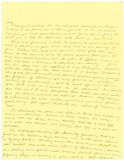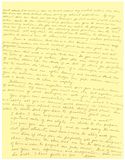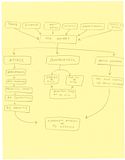Bruce Lee’s private lesson plan to his star pupil
Description
Amazing ALS in pencil, signed “Bruce,” three pages, 8.5 x 11, no date. Lee writes to Taky Kimura, his prize student and eventually one of only three Lee-certified instructors of Jeet Kun Do. In part: “First and foremost I like to impress a most important rule of teaching in your mind, and that is the economy of form. Follow this rule and you will NEVER feel like you have to ADD more and more so called sizzling techniques to keep our students interested. In order to explain ‘Economy of Form’ I’ll take a technique to illustrate the theory. Later on this idea can be applied to any technique. Together with the idea of ‘the Three Stages of a Technique [(1) synchronization of self, [2] synchronization with opponent [3] under fighting condition]. This program of teaching not only provide and endless routine of instruction, but a most efficient lesson plan that will bring result to all students. I’ve tested them here in L. A. and disregard how little we show each time…To illustrate the idea, I’ll take the Park Sao (slapping hand). Basically ‘Economy of Motion’ means all motions starts from the By-Jong position; secondly, Hands are to move first if it were hand technique [foot follows], feet first if it were foot techniques. So emphasize the above ‘Two Truths’ by practicing Park Sao fort in the touching hand manner…Each student must attack [in unison] from the By-Jong without any wasted motion. Now this has been overlooked basic theory of utmost importance. If any student does his Park Sao [or any technique for that matter] with wasted motion, back to the touching hand position he goes to minimize his unnecessary motion…I hope I have impressed in your mind a more important rule of our style-stick to the program I’ve given you, use variety, and do not worry too much that your students need more and more to stay with you-true if they can do perfectly all you’ve taught them. Remember the idea that one has to come in thousands of time in order to perfect one Judo throw. And of course use your own experience and imagination. You will do well. I have faith in you.”
The third page of Lee’s letter bears a detailed hand-written flow chart of combat strategy. At the top, Lee lists six important keys to “Combat,” which are “Timing,” “Distance,” “Speed & Rhythm,” “Initiative,” “Aggressiveness,” and “Choice of Attack.” Lee also lists three stages of combat “Attack,” “Counter-Attack,” and “Active Defense,” with other sub-categories underneath. A truly remarkable Lee letter, written to perhaps his greatest student, with a detailed explanation of his method, and a fighting flowchart in his hand, makes this an especially desirable letter. In fine condition, with mild handling wear and two deep central vertical creases to third page.



Pictures borrowed from www.rrauction.com. Click the thumbnails for bigger pictures.
NOTE: My thanks to my friend P. for the heads-up!

All I got to say is....
ReplyDeleteCOOOOL!
Thank you for posting that, that was a little treat right there. :-)